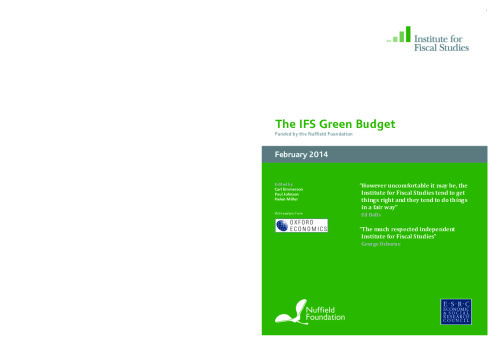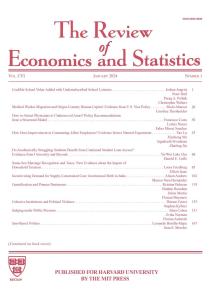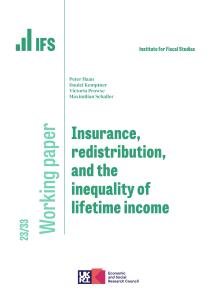The Green Budget 2014 was edited by by Carl Emmerson, Paul Johnson and Helen Miller, and copy-edited by Judith Payne. It was funded by the Nuffield Foundation with support from the ESRC through the Centre for the Microeconomic Analysis of Public Policy at IFS. The report was produced with analysis from Oxford Economics |
|
SUMMARY
Chapter 1: PUBLIC FINANCES: THE LONG ROAD AHEAD
[Download data for chapter 1 figures]
1.1 Introduction
1.2 Why a fiscal consolidation is required
1.3 The current consolidation plan
1.4 How the 2013 Autumn Statement changed the picture
1.5 Conclusion
Chapter 2: PUBLIC FINANCES: RISKS ON TAX, BIGGER RISKS ON SPENDING?
[Download data for chapter 2 figures]
2.1 Introduction
2.2 Uncertainty around the size of the problem
2.3 Risks to future tax revenues
2.4 Uncertainty around future public spending
2.5 Conclusion
Chapter 3: THE GLOBAL ECONOMY
3.1 Introduction
3.2 Global outlook
3.3 Risks to the global economy
3.4 Conclusion
Chapter 4: THE UK ECONOMIC OUTLOOK
4.1 Introduction
4.2 Will the recovery maintain its momentum in 2014 and 2015?
4.3 Medium- term recovery slower than usual
4.4 Comparison with other forecasts
4.5 Risks balanced: alternative scenarios for the UK economy
4.6 Conclusion
Chapter 5: HOUSING MARKET TRENDS AND RECENT POLICIES
5.1 Introduction
5.2 Government intervention in the housing market
5.3 Trends in the housing market
5.4 Recent innovations in housing policy
5.5 Conclusion
Appendix 5.1 Measuring changes in house prices
Chapter 6: THE SQUEEZE ON INCOMES
6.1 Introduction
6.2 Changes in incomes
6.3 Changes in living costs
6.4 Differences in inflation rates
6.5 Conclusion
Chapter 7: POLICIES TO HELP THE LOW PAID
7.1 Introduction
7.2 Who are the 'low-paid’?
7.3 Tax and benefit policies
7.4 Policies to increase pre-tax wages
7.5 Conclusion
Chapter 8: STATE SUPPORT FOR EARLY CHILDHOOD EDUCATION AND CARE IN ENGLAND
8.1 Introduction
8.2 Current policy environment
8.3 Extending children’s entitlement to ECEC
8.4 Why the government want to subsidise ECEC (and what is the evidence that it will work)?
8.5 Discussion
8.6 Conclusion
Appendix 8.1 Costing extensions of the free entitlement to ECEC
Chapter 9: WHAT IS DRIVING ENERGY PRICE RISES?
9.1 Introduction
9.2 Bills are rising whilst demand is falling
9.3 Keeping the lights and heating on
9.4 Untangling the bill to make sense of price increases
9.5 What is the problem with energy prices?
9.6 Where next for independent regulation and government intervention?
9.7 Conclusion
Chapter 10: TAXATION OF PRIVATE PENSIONS
10.1 Introduction
10.2 Principles and current practice
10.3 Options for reform
10.4 Conclusion
Chapter 11: BUSINESS RATES
11.1 Introduction
11.2 How business rates work
11.3 Assessing recent policy changes
11.4 Additional policy options
11.5 Conclusion
APPENDICES
Appendix A: Headline tax and benefit rates and thresholds
Appendix B: Abbreviations
© The Institute for Fiscal Studies, February 2014
| Buy a print copy £15.99 |











